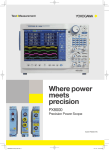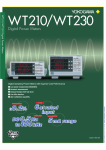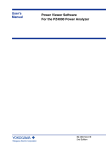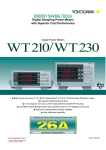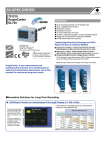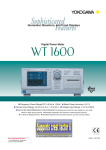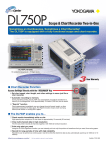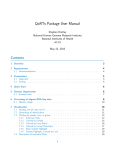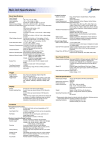Download BulletinPX8000-01EN PX8000 Precision Power Scope
Transcript
Where power meets precision PX8000 Precision Power Scope Bulletin PX8000-01EN The PX8000 brings together Yokogawa’s world-leading expertise in power measurement with our long heritage in oscilloscope design to deliver a true test and measurement revolution: the world’s first precision power scope. With the launch of the PX8000, R&D professionals need no longer compromise on their need for high-accuracy time-based power measurement, a need that conventional power analyzers and oscilloscopes were never designed to meet. As more and more innovation focuses on energy consumption and the integration of electronics into power-based systems, so more and more engineers are demanding accuracy and precision from their power measurement. The PX8000 delivers: Insight – Precision power measurement gives true insights into energy consumption and performance. Confidence – Proven, high-quality production means the PX8000 can be relied upon to deliver over extended periods of time. Familiarity – Users experience a short learning curve thanks to features familiar to anyone who’s used to power measurements or oscilloscopes. Features and benefits PX8000 Features and benefits Transient power measurement and analysis Simultaneous power calculation The PX8000 provides simultaneous voltage and current multiplication to give real-time power sampling. This supports both transient measurement (as standard) and numerical values averaged across the sample period. The available measurement period will depend on the sample rate and the memory size. Cycle-by-cycle power trend measurement Trend measurements between waveforms can be calculated by mathematical functions (up to four million points). The PX8000 provides graphical displays of voltage, current and power readings. The waveforms can be inspected for specific numerical values at any point and averages can be calculated between start and stop cursors. Such capabilities are particularly important when analyzing and optimizing the performance of, for instance, lighting and electric motors at start-up. The PX8000 has a number of innovative features that support the crucial measurement and analysis of transient power profiles. Specific time-period measurement X-Y display and phase analysis The PX8000 supports the capture of power waveforms over specific periods of time through the definition of start and stop “cursors”. This is particularly useful for examining transient phenomena and in the design of periodically controlled equipment. To ensure that equipment such as photocopiers complies with energy standards, for instance, it is vital to measure power consumption across a range of different modes from “sleep” to full activity – and all the transient states in between. For certain tasks it is important to be able to display values on an X-Y axis. Motors, for instance, are characterized by an ST-curve that shows the relationship between speed and torque. The PX8000 supports such displays as standard. It can also display lissajous waveforms of input and output for phase analysis. 2 3 Capturing sudden or irregular phenomena Long-period data capture and analysis FFT analysis Abnormal phenomena discovered during repeated high-frequency measurements can often be hard to isolate, disappearing from the screen almost as soon as they appear. The PX8000 has an always-active History function that automatically records up to 1000 historical waveforms. These waveforms can be recalled and redisplayed at any time. They can also used to redefine trigger conditions. A PC application software for the PX8000, called PowerViewerPlus, can be used to capture waveform data for further analysis. This extends the ability of the PX8000 to use mathematical functions to analyze longer term performance. The PX8000 features arithmetical, time-shift, FFT and other computations that enable users to display waveforms with offsets and skew corrections. Users can also define their own computations via equations that combine differentials, integrals, digital filters and a wealth of other functions. Historical waveforms are explored via condition-based searches. Specific abnormal phenomena, for instance, can be located by searching only for waveforms that cross – or do not cross – a certain rectangular zone. Other search parameters include waveform amplitude and RMS. PC connection is via standard Ethernet/USB/GP-IB connections. The user-friendly software displays waveforms in a simple and clear graphical style that will be familiar to users of Yokogawa’s popular Xviewer software. Researchers who want to use their own analysis software will be able to establish a connection to the PX8000 via the LabVIEW driver. Simultaneous harmonic measurement The PX8000 makes it possible to simultaneously measure the harmonic components of voltage and current waves as well as the harmonic distortion factor. Harmonic measurements take place in parallel with conventional voltage and current measurement. Harmonics up to the 500th order of the fundamental can be measured. The PX8000 in detail The PX8000 in detail 1 2 3 4 5 Display format selection: Comprehensive range of display functions for power analysis, including numeric/waveform/ vector/bar/X-Y graphs. Wiring selection: Choose between different wiring, according to the relevant electricity system: single-phase, two- and three-wire (1P2W/1P3W/3P3W) and three-phase, three- and four-wire (3P3W/3P3W(3V3A)/3P4W) connectivity. Acquire settings: Memory size setting and History function for displaying and analyzing irregular waveform data. Sampling frequency is determined by memory size and time axis selections. Module parameter settings: Measurement parameters and options include voltage/current (direct/sensor) ranges, autoranging, offset, vertical zoom, filter, scaling and synchronized sources. Power analysis settings: Analytical functions include cycle-bycycle trend calculation, specific timeperiod measurement, and harmonic analysis and FFT analysis. There is a null setting for capturing sensor input conditions. PX8000 1 2 3 4 5 Modules PX8000 Modules 1 2 Voltage module 12-bit sampling at up to 100 MS/s DC to 20 MHz bandwidth (–3 dB) 1.5 V to 1000 Vrms direct input 45 Hz to 1 kHz accuracy: 0.1% of reading, +0.1% of range Current module 12-bit sampling at up to 100 MS/s DC to 10 MHz bandwidth (–3 dB, direct input) DC to 20 MHz bandwidth (–3 dB, sensor voltage input) 10 mA to 5 Arms direct input 50 mV to 10 Vrms sensor input 45 Hz to 1 kHz accuracy: 0.1% of reading, +0.1% of range Power measurement element includes voltage and current module (up to four modules). 3 De-skewed measurement set-up Sensors can introduce phase errors or skew between the current and voltage inputs. 1 2 3 Sensor and voltage measurement module (up to three modules can be installed) Auxiliary (AUX) module 12-bit sampling at up to 100 MS/s DC to 20 MHz bandwidth (–3 dB) Up to 200 V (DC+ACpeak) via direct input Up to 1000 V (DC+ACpeak) via probe input Accuracy: 1% of range (DC) Torque and speed sensor inputs Pulse input from 2 Hz to 1 MHz Safety and error-prevention features To prevent incompatibilities, the PX8000 will detect miss-matched current and voltage modules and flag them with an on-screen warning message. The PX8000 also comes with a range of standard dedicated input connectors designed to prevent incorrect or dangerous power connections. Using these connectors, it is not possible, for instance, to connect a current to a voltage input terminal. A tie-wrap system prevents accidental current terminal disconnection. 6 Connectivity Connectivity 7 1 2 2 3 VIDEO OUT Video signal output for enhanced display on analog RGB displays GP-IB General purpose interface bus IRIG Synchronize multiple instruments via an external time source (optional) 3 4 1 4 EXT I/O The PX8000 can be used to send a GO/ NO-GO signal based on set conditions; equally external signals can be used to trigger measurement and analysis. 5 11 SD card slot SD- and SDHC-compliant 6 USB-PC Enables control from a PC 6 7 9 10 5 8 7 Long phenomena capture The large internal memory of up to 100 M Points enables long term measurements to be made at high and appropriate sample rates. USB For connection to a range of peripherals including storage, keyboard and mouse 8 Ethernet 1000 BASE-T comes as standard 9 TRIGGER IN External trigger input 10 TRIGGER OUT External trigger output 11 EXT CLK IN Sampling can be timed to an external signal (up to 9.5 MHz) Power meets precision PX8000 Power meets precision Focus on precision R&D teams everywhere are coming to terms with the need for new levels of precision in power measurement. With pervasive microprocessor control and on-going pressure to reduce energy consumption, the lines between electrical and electronic engineering continue to blur – and the need for a new class of hybrid measurement is emerging. Traditional power measurement instruments cannot provide accurate time measurements; oscilloscopes are not designed to measure power. The PX8000 is the world’s first precision power scope, bringing oscilloscope-style time-based measurement to the world of power measurement. The PX8000’s time-based accuracy brings a new dimension to power analysis. It can capture voltage and current waveforms precisely, opening up applications and solutions for a huge variety of emerging power measurement problems. 8 The PX8000 brings high-precision waveform capabilities to power measurement. Among the features unique to the PX8000 are: Multifunction snapshots Up to 16 different waveforms – including voltage, current and power – can be displayed side-by-side, giving engineers instant snapshots of performance. Detailed transient analysis The PX8000 supports the measurement of all power waveform parameters between precisely defined start and stop cursors. Trend calculation The PX8000 has built-in functions for the direct calculation of variables, such as root mean square (RMS) and mean power values, to enable the identification of cycle-by-cycle trends. De-skew compensation The PX8000’s de-skewing function eliminates offsets between current and voltage signals that may be caused by sensor or input characteristics. The Yokogawa power analyzer series The PX8000 is the new flagship product for Yokogawa’s range of industry-proven power analyzers. Yokogawa’s first power measurement instrument was designed back in the 1960s, and its power analyzers have played an important role in sustainable industrial development ever since. isoPRO – pioneering measurement technology TM The PX8000 is powered by Yokogawa’s isoPRO technology, which offers industry-leading isolation performance at the highest speeds. isoPRO core technology, designed with energy-saving applications in mind, delivers the performance needed to develop high-efficiency inverters that operate at high voltages, large currents and high frequency. TM 9 Focus on power Innovators everywhere are focusing on key questions that can only be answered by measuring power precisely. How can we minimize energy loss? How can we boost performance? How can we efficiently use renewable energy sources? Inverter performance and efficiency Photovoltaic cells for solar power Smart grid solutions Electric/hybrid vehicles Wireless power charging Applications Applications The PX8000 is an immensely versatile instrument, unlocking precision power measurement capabilities for researchers working on everything from renewable power to advanced robotics. Anywhere that power consumption is at a premium – which means almost anywhere power is consumed – can benefit from the introduction of the PX8000’s precision measurement and analysis capabilities. The following pages cover some typical applications for the PX8000. For help in designing your own measurement strategy, please contact your usual Yokogawa representative. PX8000 10 Inverter and motor testing Inverter and motor testing The PX8000 advantage Overview The vertical resolution of analog/digital conversion is one of the most important factors in precision measurement. The PX8000 has 12-bit resolution with 100 MS/s sampling and 20 MHz bandwidth. This means the PX8000 can be used for accurate measurement of inverter pulse shapes, which can then be used to fine-tune inverter efficiency. Wide bandwidth Measurement accuracy as a % of range Electric and hybrid vehicles have many electrical and mechanical components, and overall performance evaluation requires measuring the efficiency of both. The PX8000’s flexibility, accuracy and wide bandwidth make it ideal for drawing together the range of power readings needed to optimize the efficiency of boost circuits and inverters – two key elements in overall electric vehicle performance. Transient measurement by cycle-by-cycle trend 9 7 Inverter section Input 5 Motor 3 Booster Converter section Batteries 1 −1 Load Drive circuit Temperatures 1 10 Torque/ rotation sensor Voltage/Current 2 Speed/Torque 3 100 1000 10000 Modulate and convert DC to AC signals 100000 4 Ext 2 V × 15 V range (1) (2) (3) (4) 0.5 A × 15 V range Harmonic and FFT analysis PX8000 02. A × 150 V range The PX8000 has both harmonic and FFT measurement capabilities for frequency-based analysis. The Harmonic function can measure fundamental waveforms from 20 Hz to 6.4 kHz. This is particularly useful for analyzing higher harmonic component and causes of noise in electromechanical systems. Energy measurement of batteries Efficiency measurement of boost circuit and drive circuit Efficiency measurement of inverter system above transient behavior measurement 3 2 Offset cancels by individual NULL function 1 0 −1 −2 −3 The PX8000’s ability to analyze cycle-by-cycle trends makes it ideal for the measurement of transient effects. During the start-up phase of an inverter and motor, for example, current increases can be analyzed in each cycle. And when the load changes rapidly, the engineers can gain insights that will enable them to improve the control of the inverter. 1000000 Frequency (Hz) Measurement accuracy as a % of range 11 10 100 1000 10000 100000 1000000 Frequency (Hz) 5 A range Ext 2 V range 150 V range 0.2 A × 150 V range Measurement accuracy as a % of range vs. frequency (Hz) at power factor = 1. 7 6 5 4 A common problem when testing inverter motors is the presence of ambient noise that can mean test values are nonzero even before testing begins. The PX8000’s offset capabilities mean such effects can be nullified and specific inputs can be isolated for testing and analysis. Reactor loss measurement of inverter boost circuits Reactor loss measurement of inverter boost circuits PX8000 The PX8000 advantage Low-power-factor measurement Overview Higher sampling rates and broad bandwidth make the PX8000 particularly useful for testing devices, such as transformers and reactors, that have lower power factors. It is particularly important to measure the precise power consumption of such devices at high frequency. A reactor is used to filter out noise and boost voltage levels De-skew functionality prior to the use of an inverter. It consists of an electromagnetic material core and a coil. A main focus for electrical engineers is to reduce power loss across the total inverter system, and reactor performance is of particular interest. There are two potential evaluation methods: direct loss measurement of the reactor and iron loss measurement. The PX8000 supports either methodology because it can accommodate both high frequency measurement and low-power-factor conditions. Inverter Reactor N1 Core loss measurement under high frequency Analyzing reactor core loss is an example of how the PX8000’s user-defined functions can be utilized to provide an instant analysis of system performance. PX8000 Variable Power Supply To analyze power consumption in low-power-factor devices it is particularly important to minimize any time differences between voltage and current caused by sensor input characteristics. The PX8000 provides precise de-skew adjustment to compensate for this time difference. N2 In this example, core loss is calculated based on primary coil current and secondary coil voltage (using readings from an Epstein device), while magnetic flux density (B) and magnetic field (H) are calculated by factoring in input frequency, cross-sectional area and other parameters. All values can be displayed directly by the PX8000. Core loss = Power value (W) × N1 N2 Measurement items specified using user-defined function as follows: Current Measurement PX8000 Voltage Measurement B= H= Voltage (mean) 2 ∏ × Current freq. × N2 × cross section N1 × Primary coil peak current Effective magnetic path length 12 Transient responses of industrial robots 13 Transient responses of industrial robots The PX8000 advantage Overview The PX8000 supports the measurement of waveform data between specific Start /Stop cursors. Combined with its multi-channel capabilities and its Long memory and History functions, this makes the PX8000 particularly useful in rating a robot’s operational power consumption. To evaluate motor-driven robots, power consumption of all motors and controllers are measured throughout all operational speeds and action patterns. Design engineers need to measure inrush voltage, current and power over the pattern of repeated actions. Efficiency is calculated by comparing mechanical output with input power. During actual operating conditions, the time to accelerate and decelerate such motors can range from several hundred milliseconds to several seconds. As a PWM-driven motor rotates from the reset position to the top speed, the drive frequency changes from DC to several hundred Hz. The PX8000 gives design engineers insight into power consumption and efficiency throughout a robot’s operational performance. Pin Pout Robot Controller Efficiency measurement of boosters, inverters and motors A single PX8000 unit can measure both the input/ output power of inverters and the mechanical output of a motor. By installing three power units and one AUX module, the PX8000 can be configured to provide an instantaneous measure of component efficiency. Transient measurement by trend computation Motor Robot Other Motors Specific time-period analysis With its instantaneous power calculations, the PX8000 is ideal for evaluating and optimizing transient effects. Its cycle-by-cycle trend analysis provides further insights into this crucial area of robotics engineering. Longer time-period measurement PX8000 To analyze some robotic operations, it may be necessary to perform cycle-by-cycle trend analysis over a long period of time. The PowerViewerPlus software extends this mathematical capability to enable deep insights to be obtained from the data. Wireless charger efficiency measurement PX8000 Wireless charger efficiency measurement The PX8000 advantage Wireless charger efficiency evaluation Overview The development of wireless charging technology for mobile devices like smartphones and tablet devices is a focus for research. Automotive manufacturers are looking into the possibilities of charging electric vehicles wirelessly too. Wireless charging depends on two electromagnetic coils being configured to support particular frequency profiles. Efficient power transfer and the prevention of power loss are naturally particularly important. The PX8000 is ideally suited for measuring such systems because of its ability to operate at high frequencies and low power factors. To evaluate the efficiency of wireless transfer (including inverters), at least three power measurement elements are required. The PX8000, with its four input channels, can analyze the performance of the whole system simultaneously. Low-power-factor device measurement The PX8000’s higher sampling rates and broad bandwidth make it ideally suited for wireless power transfer systems. (The PX8000 supports 12-bit resolution, sample rates of up to 100 MS/s and a 20 MHz bandwidth.) Crucially, this means the PX8000 supports the measurement of low-power-factor Measurement accuracy as a % of range systems operating at very high frequencies. 9 De-skew functionality 7 Because the PX8000 provides a de-skew function, differences between voltage and current that are introduced by sensor and input characteristics can be compensated for and therefore eliminated from 5 3 1 −1 the analysis of low-power-factor systems. 10 100 1000 10000 100000 1000000 Frequency (Hz) Ext 2 V × 15 V range 02. A × 150 V range 0.5 A × 15 V range Measurement accuracy as a % of range vs. frequency (Hz) at power factor = 0. Inverter Measurement accuracy as a % of range 3 D1 Oscillate Coil Receive Coil C3 D2 Q2 C4 Load (Non-inductive) 1 0 Signal Oscillator −1 PX8000 −2 −3 Capacitor Q1 DC Power Supply 2 Capacitor 10 100 1000 10000 100000 1000000 Frequency (Hz) 5 A range Ext 2 V range 150 V range 0.2 A × 150 V range 14 Power distribution 15 Power distribution The PX8000 advantage Overview Simultaneous three-phase data capture Power distribution systems have to maintain constant voltage and constant power during load switching or in the case of a short circuit. Distribution protectors or circuit breakers for three-phase electricity systems must therefore be tested at transient voltage and power levels. To evaluate three-phase electrical systems, at least three power measurement inputs are required. The PX8000 not only has four inputs but also enables the simultaneous capture and display of voltage and current across all three phases. The PX8000 can capture fluctuating voltage and current waveform, calculate power parameters (including voltage and current values), determine an average over a specified period and display all values. Specific time-period measurement Protector Protector Voltage Converter Voltage Converter Protector Voltage Converter PX8000 Protector Voltage Converter For a true evaluation of distribution protection, it is necessary to measure a full cycle of voltage, current and power values half a cycle after the recovery from a short circuit. The PX8000 can easily be set up to focus on such a specific period. Harmonic and FFT analysis Short The PX8000 has capabilities for both harmonic measurement and FFT for frequency analysis. The harmonic function can measure fundamental frequencies from 20 Hz to 6.4 kHz, and FFT has 1 k to 100 k points calculation across up to two channels. Such measurements are vital for identifying harmonic currents and identifying sources of noise. Specifications of PX8000 and the modules PX8000 Input Zoom Display Shape Plug-in input module style Module structure Voltage module, Current module and Auxiliary (AUX) module Power measurement element: one Voltage module and one Current module Max. 8 modules (max. 4 power measurement elements) can be installed AUX module can be installed max. 3 (at least one power measurement elements must be installed). Max. channel number 8 ch, combination of Voltage/Current modules and AUX module Max. record length Standard 10 M points for each voltage and current regardless of the installed number of modules. The memory cannot be combined, each memory of module is individual. 50 M points for each voltage and current regardless of the installed channel number of input modules when /M1 option is installed. Zoom FFT Input terminal type Voltage: Plug-in terminal (female) Current: Direct input: Plug-in terminal (male) External current sensor input: isolated BNC Input format X-Y Display Measurement range Voltage: 1 .5/3/6/10/15/30/60/100/150/300/600/1000 Vrms (crest factor=2 at rated range input) Current: D irect input (5 A) 10 m/20 m/50 m/100 m/200 m/500 m/1/2/5 Arms (Crest factor=2 at rated range input) Current: E xternal current sensor input 50 m/100 m/200 m/500 m/1/2/5/10 Vrms (Crest factor=2) Line filter Select from OFF, 500 Hz, 2 kHz, 20 kHz, and 1 MHz. Frequency filter Select from OFF, 100 Hz, 500 Hz, 2 kHz and 20 kHz. A/D converter Max sample rate Resolution: 12 bit Conversion ratio (sampling period): Approx. 10 ns. (100 MS/s) For harmonic measurement, please refer to harmonic function. Auxiliary (AUX) module (760851) Specification Number of input channels 2, switchable analog or pulse input Input coupling AC, DC, or GND Input format Isolated unbalanced Frequency characteristics DC to 20 MHz (−3 dB point when sine wave of amplitude ±3 div is applied) Voltage-axis sensitivity setting 50 mV to 100 V (1-2-5 steps) (when using 1: 1 probe attenuation) A/D conversion resolution 12 bit The X and Y axes can be selected from Un/In/Pn/AUXn, MATHn (Max. four traces, two windows). Measurement Function and Conditions Crest Factor Up to 200 (effective minimum input). Up to 2 (rated input) CfU: Voltage crest factor, CfI: Current crest factor Measurement period Measurement period to calculate numerical values -Period of measurement update cycle based on zero crossing or external gate signal source signal -8192 points for harmonic measurement from specified start cursor Wiring method 1P2W (Single phase 2 wire), 1P3W (Single phase 3 wire), 3P3W (3 phase 3 wire), 3V3A (3 phase 3 wire, 3 power meter method), 3P4W (3 phase 4 wire) Scaling 0.0001 to 99999.9999 can be set for scaling of VT ratio, CT ratio and power ratio when external current sensor, VT or CT are used for the input Linear scaling function is available for AUX module (760851) Voltage: Floating input, resistive voltage divider Current: Floating input through shunt Power spectrum of input waveform, Max. two windows X-Y display 100 M points for each voltage and current regardless of the installed channel number of input modules when /M2 option is installed. Voltage/Current input modules (760811/760812) Specifications Expand the displayed waveform along with the time axis (up to 2 separate locations). The zoom position can be automatically scrolled. FFT Display Frequency measurement Number of displayed digits Full 5 digits (99999) Max frequency 5.0000 MHz Accuracy ±0.1 of reading Frequency Measurement filter Same as Zero-cross filter (OFF/100 Hz/500 Hz/2 kHz/20 kHz) Harmonics measurement Method PLL synchronization method (not available for external sampling clock function) Frequency range The range for the fundamental frequency of the PLL source is 20 Hz to 6.4 kHz, and sampling frequency is more than 2 MS/s. Time/div is 2 ms/div or higher. ACQ Time Base is set to Int FFT data length 8192, the analysis (calculation) start point can be set freely in the acquisition memory data. Acquisition data length is required twice of window length. Window function Rectangular Sample rages, window width and upper limits of harmonic analysis Fundamental freq. Sample rate Window width Upper limit of harmonics 20 Hz to 600 Hz f × 1024 8 cycles 500 order 600 Hz to 1200 Hz f × 512 16 cycles 255 order 1200 Hz to 2600 Hz f × 256 32 cycles 100 order 2600 Hz to 6400 Hz f × 128 64 cycles 50 order Accuracy Line filter OFF Add below expression to normal measurement Voltage & current:(0.001 × f + 0.001 × n)% of reading + 0.1% of range Power: (0.002 × f + 0.002 × n)% of reading + 0.2% of range f: unit kHz Temperature coefficient ±(0.1% of range/˚C) (typical) Bandwidth limit Select from OFF, 2 MHz, 1.28 MHz, 640 kHz, 320 kHz, 160 kHz, 80 kHz, 40 kHz, 20 kHz, and 10 kHz Cut-off characteristics: −18 dB/OCT (when 2 MHz, Typical) Accuracy (analog) DC: ±1% of range (typical) * Measured under the standard operating conditions Frequency measurement range 2 Hz to 1 MHz, displaying range: 1.8 Hz to 2 MHz Pulse width 500 ns or wider Zoom Accuracy (pulse) ±(0.05% of reading) ±1 count error (10 ns), Except, the observation time is greater or equal to 300 times the period of the pulse. Expand the displayed waveform along with the time axis (up to 2 separate locations). The zoom position can be automatically scrolled. Display format 1/2/3/4/6/8/12, and 16 analog waveform windows Snapshot The currently displayed waveforms can be retained on the screen. Snapshot waveforms can be saved and loaded. Trigger Function Trigger mode Waveform data acquisition and display Acquisition mode Auto, Auto Level, Normal, Single, N Single, or On Start Normal: Normal waveform data acquisition Envelop: The peak values are held at the maximum sample rate regardless of the Time/div setting. Averaging: The number of times to average can be set to 2 to 65536 in 2n steps. Vertical and Horizontal Control Simple Trigger Trigger source Un, In, Pn, AUXn, EXT, LINE, or Time n = channel number Channel ON/OFF Un, In, Pn, AUXn or MATHn can be turned ON and OFF separately Time Trigger Date (year, month, and day), time (hour and minute), and time interval (10 seconds to 24 hours) Vertical axis zooming × 0.1 to × 100 Upper and lower limits can be used to set the scale. Roll Mode Roll mode is enabled automatically when the trigger mode is set to Auto, Auto Level, Single, or On Start, and the time axis setting is greater than or equal to 100 ms/div. Enhanced trigger Trigger source Un, In, Pn, AUXn or EXT Trigger type A → B(N): A Delay B: Edge on A: AND: OR: B>Time: B<Time: B Time Out: B Between: Period: T>Time T<Time: T1<T<T2: T<T1, T<T2: Wave Window Analysis Functions Power parameters calculation Calculate Voltage, Current. Power, Delta parameters, frequency and AUX values from captured waveforms Apparent power, reactive power and power factor and those Sigma values are calculated from the Voltage, Current and Power values Automated measurement of Waveform parameters Up to 24 items can be displayed P-P, Amp, Max, Min, High, Low, Avg, Mid, Rms, Sdev, +OvrShoot, −OvrShoot, Rise, Fall, Freq, Period, +Width, −Width, Duty, Pulse,Burst1, Burst2, AvgFreq, AvgPeriod, Int1TY, Int2TY, Int1XY, Int2XY, Int1hXY (IntegPower/IntegCurrent) Int2hXY (IntegPower/IntegCurrent) Statistical processing Application items: Automated measurement values of waveform parameters Statistical items: Max, Min, Avg, Sdv, and Cnt Cyclic statistical processing Automatically measures the waveform parameters of the data in the acquisition memory and performs statistical processing on the parameters once per period. User defined computation (MATH) Max. 8 expressions for waveforms MATH1 to MATH8, Max. 4 Mpoint, regarding Digital filter +, −, *, /, SHIFT, ABS, SQRT, LOG, EXP, NEG, SIN, COS, TAN, ATAN, PH, DIF, DDIF, INTG, IINTG, BIN, SQR, CUBE, F1, F2, FV, PWHH, PWHL, PWLH, PWLL, PWXX, DUTYH, DUTYL, FILT1, FILT2, HLBT, MEAN, LS-, PS-, PSD-, CS-, TF-, CH-, MAG, LOGMAG, PHASE, REAL, IMAG, TREND, TRENDM, TRENDD, TRENDF, _HH, _LL, _XX and ZC User defined computation (numeric) Max. 20 expressions, F1 to F20 +, −, *, /, ABS, SQRT, LOG, EXP and NEG De-sckew function Compensate the phase difference between voltage and current modules of a power measurement element GO/NO-GO determination Two types of GO/NO-GO determination are available Time Base Time axis setting (Observation time) "Time/div" Time/div setting: 100 ns/div to 1 s/div (1-2-5 step), 2 s/div, 3 s/div, 4 s/div, 5 s/div, 6 s/div, 8 s/div, 10 s/div, 20 s/div, 30 s/div, 1 min/div and 2 min/div Observation time: 1us to 1200 s Display Display 10.4 inch TFT LCD display Number of dots 1024 × 768 XGA Waveform displaying dot size 801 × 656 (Waveform Display) Displaying format Combination: Max. 2 types of format can be displayed Numeric 4 items/ 8 items/ 16 items/Matrix/All/Single List/Dual List/Custom Wave 1/2/3/4/6/8/12/16 Bar Single/Dual/Triad Vector Single/Dual ZOOM1 and ZOOM2 (divided lower display area) FFT1 and FFT2 (divided lower display area) XY1 and XY2 (divided lower display area) Display update Depends on setting of observation time and record length Numerical Display Max. digit of numeric display Selected full 5 digits (displaying 99999), or 6 digits (999999) Number of displayed items Select from 4, 8, 16, Matrix, All, Single List, Dual List, and Custom Waveform Display Displaying items Maximum 16 waveforms Voltage, current and power of Element 1 Voltage, current and power of Element 2 (or AUX3 and AUX4 of Element 2) Voltage, current and power of Element 3 (or AUX5 and AUX6 of Element 3) Voltage, current and power of Element 4 (or AUX7 and AUX8 of Element 4) File Functions MATH 1 to MATH 8 FFT Function Bar graph display Setup data, Waveform data (including History data), Numeric data and Image data can be saved external media. Waveform data (including History data up to 1000 waveform) and setup data Waveform to be computed Vector Bar Graph Display (option) Vector display Save Load Display the phase angle between the fundamental voltage signal and fundamental current signal as a vector Display a bar graph of the amplitude of each harmonics when it is harmonic measurement. Un, In, Pn, AUXn and MATHn Number of channels 2 Computation range From the specified computation start point until the specified number of points have been computed 16 Computed points 1 k, 2 k, 5 k, 10 k, 20 k, 50 k, or 100 k Time windows Rectangular, Hamming, Hanning, Flat top, or Exponential Built-in Printer (/B5 Option) Print system Thermal line dot system Sheet width 112 mm Storage Functions SD Card Number of slot 1 Max. capacity 16 GB Supported cards SD and SDHC compliant memory card USB Ports for Peripherals Compatible USB storage devices Mass storage devices that are compliant with USB Mass Storage Class Ver. 1.1 USB Peripheral Interface Number of ports 17 2 Electrical and mechanical specifications USB Rev. 2.0 compliant Supported transfer mode HS (High Speed, 480 Mbps), FS Full Speed, 12 Mbps), and LS Low Speed, 1.5 Mbps) Input/Output EXT TRIG IN Connector type Active Power (W) P(k): k-th order active power value, P: total active power value When k=0, it shows DC component Apparent Power (VA) S(k): k-th order apparent power value, S: total apparent power value When k=0, it shows DC component Reactive Power (Var) Q(k): k-th order reactive power value, Q: total reactive power value When k=0, it shows 0 Power Factor Lambda(k): k-th order power factor value, Lambda: total power factor value Phase Angle (deg) Phi(k): P hase angle between k-th order voltage and current, Phi: Phase angle of current refers to voltage waveform PhiU(k): Phase angle of k-th order voltage refers to the fundamental voltage U(1) PhiI(k): Phase angle of k-th order current refers to the fundamental current I(1) Delta Function Voltage [V] Delta U1 to Delta U3, and Delta Usigma Current [A] Delta I Power [W] Delta P1 to Delta P3, and Delta PSigma AUX analysis function Torque and Speed input AUX1 Pulse input or Analog input AUX2 Pulse input or Analog input AUX(1×2) Mechanical power calculation Accuracy BNC Input level TTL Minimum pulse width 100 ns Accuracy (at 6 months) Voltage: FrequencyAccuracy DC:±(0.2% of reading + 0.2% of range) 0.1 Hz ≤ f < 10 Hz:±(0.2% of reading + 0.2% of range) 10 Hz ≤ f < 45 Hz:±(0.2% of reading + 0.1% of range) 45 Hz ≤ f ≤ 1 kHz:±(0.1% of reading + 0.1% of range) 1 kHz < f ≤ 10 kHz:±(0.1% of reading + 0.1% of range) 10 kHz < f ≤ 50 kHz:±(0.2% of reading + 0.2% of range) 50 kHz < f ≤100 kHz:±(0.6% of reading + 0.4% of range) 100 kHz < f ≤200 kHz:±(0.6% of reading + 0.4% of range) 200 kHz < f ≤400 kHz:±(1% of reading + 0.4% of range) 400 kHz < f ≤500 kHz:±((0.1 + 0.003 × f*)% of reading + 0.4% of range) 500 kHz < f ≤ 1 MHz:±((0.1 + 0.003 × f*)% of reading + 4% of range) 1 MHz < f ≤ 10 MHz:±((0.1 + 0.003 × f*)% of reading + 4% of range) Current: Direct (up to 5 A) FrequencyAccuracy DC:±(0.2% of reading + 0.2% of range) + 20 uA 0.1 Hz ≤ f < 10 Hz:±(0.2% of reading + 0.2% of range) 10 Hz ≤ f < 45 Hz:±(0.2% of reading + 0.1% of range) 45 Hz ≤ f ≤ 1 kHz:±(0.1% of reading + 0.1% of range) 1 kHz < f ≤ 10 kHz:±(0.1% of reading + 0.1% of range) 10 kHz < f ≤ 50 kHz:±(0.2% of reading + 0.2% of range) 50 kHz < f ≤100 kHz:±(0.6% of reading + 0.4% of range) 100 kHz < f ≤200 kHz:±(0.6% of reading + 0.4% of range) 200 kHz < f ≤400 kHz:±(1% of reading + 0.4% of range) 400 kHz < f ≤500 kHz:±((0.1 + 0.004 × f*)% of reading + 0.4% of range) 500 kHz < f ≤ 1 MHz:±((0.1 + 0.004 × f*)% of reading + 4% of range) EXT TRG OUT Connector type BNC Output level 5 V CMOS Logic Low when a trigger occurs and high after acquisition is completed EXT CLK IN Connector type BNC Input level TTL Minimum pulse width 50 ns * Measurement bandwidth 20 MHz (−3 dB, Typical) * Accuracy over 1 MHz is design value Video Output Connector type D-Sub 15 pin receptacle Output format Analog RGB Output resolution XGA-compliant output 1024 × 768 dots Approx. 60 Hz Vsync (dot clock frequency: 66 MHz) GO/NO-GO Determination I/O Connector type RJ-11 modular jack Input level TTL or contact External Start/Stop Input Connector type RJ-11 modular jack * Measurement bandwidth 10 MHz (−3 dB, Typical) Input level TTL or contact Sensor Frequency Accuracy DC:±(0.2% of reading + 0.2% of range) + 50 uV 0.1 Hz ≤ f < 10 Hz:±(0.2% of reading + 0.2% of range) 10 Hz ≤ f < 45 Hz:±(0.2% of reading + 0.1% of range) 45 Hz ≤ f ≤ 1 kHz:±(0.1% of reading + 0.1% of range) 1 kHz < f ≤ 10 kHz:±(0.1% of reading + 0.1% of range) 10 kHz < f ≤ 50 kHz:±(0.2% of reading + 0.2% of range) 50 kHz < f ≤100 kHz:±(0.6% of reading + 0.4% of range) 100 kHz < f ≤200 kHz:±(0.6% of reading + 0.4% of range) 200 kHz < f ≤400 kHz:±(1% of reading + 0.4% of range) 400 kHz < f ≤500 kHz:±((0.1 + 0.003 × f*)% of reading + 0.4% of range) 500 kHz < f ≤ 1 MHz:±((0.1 + 0.003 × f*)% of reading + 4% of range) 1 MHz < f ≤ 10 MHz:±((0.1 + 0.003 × f*)% of reading + 4% of range) Comp Output Output signal frequency 1 kHz ±1% Output amplitude 1 Vp-p ±10% Probe Power Output (/P4 Option) Number of output terminals 4 Output voltage ±12 Vdc Output current Total max. of 1 A Time Sync Signal Input (IRIG: /C20 option) Input connector BNC Supported IRIG signals A002, B002, A132, and B122 Input impedance Can be switched between 50 Ohm and 5 kOhm. Maximum input voltage ±8 V * Measurement bandwidth 20 MB (−3 dB, Typical) * Accuracy over 1 MHz is design value Power: GP-IB Connector type 24-pin connector Electrical specification Complies with IEEE St’d 488-1978 (JIS C 1901-1987) Functional specification SH1, AH1, T6, L4, SR1, RL1, PP0, DC1, DT0, and C0 Protocol IEEE St'd 488.2-1992 Ethernet Connector type RJ-45 modular jack Transmission system Ethernet (1000 BASE-T, 100 BASE-TX or 10 BASE-T) Communication protocols TCP/IP Sensor Frequency Accuracy DC:±(0.2% of reading + 0.4% of range) + 50 uV × U 0.1 Hz ≤ f < 10 Hz:±(0.2% of reading + 0.2% of range) 10 Hz ≤ f < 45 Hz:±(0.2% of reading + 0.1% of range) 45 Hz ≤ f ≤ 1 kHz:±(0.1% of reading + 0.1% of range) 1 kHz < f ≤ 10 kHz:±(0.1% of reading + 0.16% of range) 10 kHz < f ≤ 50 kHz:±(0.2% of reading + 0.2% of range) 50 kHz < f ≤100 kHz:±(0.6% of reading + 0.4% of range) 100 kHz < f ≤200 kHz:±(1.5% of reading + 0.6% of range) 200 kHz < f ≤400 kHz:±(1.5% of reading + 0.6% of range) 400 kHz < f ≤500 kHz:±((0.1 + 0.004 × f*)% of reading + 0.6% of range) 500 kHz < f ≤ 1 MHz:±((0.1 + 0.004 × f*)% of reading + 6% of range) USB Connector type USB type B receptacle Electrical and mechanical specifications USB Rev. 2.0 compliant Supported transfer modes HS (High Speed, 480 Mbps) and FS Full Speed, 12 Mbps) Display Items Numerical Values Normal Measurement functions for each channel (power measurement element) Voltage (V) Urms: true rms value, Umn: rectified mean value calibrated rms value, Udc: simple average value, Urmn; rectified mean value, Uac: AC component Current (A) Irms: true rms value, Imn: rectified mean value calibrated rms value, Idc: simple average value, Irmn; rectified mean value, Iac: AC component Active Power (W) P Apparent Power (VA) S: selectable of Urms × Irms, Umn × Imn, Udc × Idc, Urmn × Irmn or Umn × Irms Direct (up to 5 A) Frequency Accuracy DC:±(0.2% of reading + 0.4% of range) + 20 uA × U 0.1 Hz ≤ f < 10 Hz:±(0.2% of reading + 0.2% of range) 10 Hz ≤ f < 45 Hz:±(0.2% of reading + 0.1% of range) 45 Hz ≤ f ≤ 1 kHz:±(0.1% of reading + 0.1% of range) 1 kHz < f ≤ 10 kHz:±(0.1% of reading + 0.16% of range) 10 kHz < f ≤ 50 kHz:±(0.2% of reading + 0.2% of range) 50 kHz < f ≤100 kHz:±(0.6% of reading + 0.4% of range) 100 kHz < f ≤200 kHz:±(1.5% of reading + 0.6% of range) 200 kHz < f ≤400 kHz:±(1.5% of reading + 0.6% of range) 400 kHz < f ≤500 kHz:±((0.1 + 0.006 × f*)% of reading + 0.6% of range) 500 kHz < f ≤ 1 MHz:±((0.1 + 0.006 × f*)% of reading + 6% of range) * The unit of f in the equation for the reading error is (kHz). * These accuracies apply when the power factor = 1. For the complete specifications, please refer to the separate document, Bulletin PX8000-02EN. General specifications Standard operating conditions Ambient temperature: 23 ±5˚C, Ambient humidity: 20 to 80%RH, Supply Voltage and frequency Within ±1% of rating, Altitude: 2000 m or less After the PX8000 has been warmed up for 30 minutes and then calibration has been performed. Reactive Power (Var) Q Power Factor Lambda (P/S) Rated supply voltage 100 to 120 VAC / 220 to 240 VAC (Auto switching) Phase Angle (deg) Phi (cos −1 P/S) Rated supply frequency 50/60 Hz Maximum power consumption 200 VA Weight Approx. 6.5 kg (weight of the PX8000 only without paper and /M2, /B5, /C20, /G5 and /P4 options) Withstand voltage 1500 VAC for one minute between the power supply and case Insulation resistance 10 M ohm or more for 500 VDC between the power supply and case Harmonic analysis function (/G5 Option) Sigma Items Voltage (V) U(k): k-th order voltage true rms value, U: total voltage true rms value When k=0, it shows DC component Current (A) I(k): k-th order current true rms value, I: total current true rms value When k=0, it shows DC component Model Suffix Code PX8000 Power Code Languages Options Description Precision Power Scope -D -F -H -N -Q -R UL/CSA Standard VDE standard GB standard NBR standard BS standard AS standard -HE -HG -HJ English menu German menu Japanese menu /B5 /C20 /G5 /M1 /M2 /P4 Built-in printer (112 mm) IRIG function Harmonic measurement 50 M memory expansion* 100 M memory expansion* 4 Outputs of probe power *Select one of these Model/ Product parts number Description 366924 *1 BNC-BNC Cable 1m 366925 *1 BNC-BNC Cable 2m 366926 *1 1:1 BNC-Alligator Cable Non-isolated 42 V or less 1 m 366961 *1 1:1 Banana-Alligator Cable Non-isolated 42 V or less 1.2 m 700924 Differential Probe 1400 Vpk, 1000 Vrms-CAT II 700929 10:1 Probe (for isolation BNC input) 1000 V (DC+ACpeak) CAT I 701901 1:1 Safety BNC Adapter Lead (in combination with followings) 1000 Vrms-CAT II 701902 Safety BNC-BNC Cable (1 m) 1000 Vrms-CAT II (BNC-BNC) 701903 Safety BNC-BNC Cable (2 m) 1000 Vrms-CAT II (BNC-BNC) 701906 Long Test Clip For 700924 and 701926 701926 Differential Probe Max. 7000 Vpk, 5000 Vrms 701947 100:1 Isolation Probe 1000 V (DC+ACpeak) CAT I Name Model Description 701948 Plug-On Clip For 700929 and 701947 Voltage Module 760811 Voltage module (Current module 760812 must be ordered together.) 701954 Large Aligator-Clip (Dolphin type) 1000 Vrms-CAT II, 1 set each of red and black Current Module 760812 Current module (Voltage module 760811 must be ordered together.) 701959 Safety Mini-Clip (Hook type) 1000 Vrms-CAT II, 1 set each of red and black Auxiliary Module 760851 Auxiliary (AUX) module for sensor input, Torque/Speed Name Model Description PowerViewerPlus 760881 Viewer software dedicated for PX8000 (coming soon) - The German language menu will be released soon. - Selection of both /M1 and /M2 is not available for one main frame. The standard memory length is 10 M points/CH. - The power value will be calibrated using a pair of Voltage (760811) and Current (760812) modules, therefore an equal quantity of these must be ordered together. - A test Certificate of the Voltage Module includes the test results of the voltage and power values which are calibrated with one paired Current Module. Also the test Certificate of the Current Module includes the test results of the current and power values which are calibrated with one paired Voltage Module. <Cautions regarding the installation of modules and their location> - The PX8000 has a maximum of 8 slots for installing modules. - It is required to equip the PX8000 main frame with at least one Voltage Module and one Current Module in slots 1 and 2 to create one Power Measurement Element. The PX8000 can be equipped with a maximum of three additional Power Measurement Elements. - When modules are ordered with the PX8000 main frame, the modules are factory installed in the main frame up to a combined maximum of 4 power measurement elements and auxiliary modules. Priority is given to the installation of power measurement elements. - The location of modules can be changed by the customer. However, slot 1 must be always containing a Voltage Module and slot 2 must always contain a Current Module. - Power values are calibrated using one Voltage Module and one Current Module, so the same number of these modules must be ordered together. In the case of service, repair or re-calibration, both modules must be sent together to the service department. - Up to 3 AUX Modules can be installed in odd numbered slot only (3, 5 and 7). Odd numbered slots (3, 5 and 7) are also used to install additional Voltage Modules, and even numbered slots (4, 6 and 8) for additional Current Modules. 701963 Soft Carrying Case For PX8000 720911 External I/O Cable For external I/O connection 758917 Test Lead Set A set of 0.8 m long, red and black test leads 758921 Fork Terminal Adapter Banana-fork adapter, Two adapters to a set 758922 Small Alligator-clip Rated at 300 V and used in a pair 758923 Safety Terminal Adapter (spring-hold type) Two adapters to a set 758929 Large Alligator-clip Rated at 1000 V and used in a pair B8213ZA Safety Terminal Adapter (screw-fastened type) Two adapters to a set for current B8213ZD Safety Terminal Adapter (screw-fastened type) Two adapters to a set for voltage B9284LK External Sensor Cable Current sensor input connector, Length 0.5 m B9317WD Wrench For B8213ZD and B8213ZA B9988AE Printer Roll Paper For PX8000, 10 m × 10 CT60 AC/DC Current Sensor Max. 60 Apk, DC to 800 kHz (−3 dB) CT200 AC/DC Current Sensor Max. 200 Apk, DC to 500 kHz (−3 dB) CT1000 AC/DC Current Sensor Max. 1000 Apk, DC to 300 kHz (−3 dB) Due to the nature of this product, it is possible to touch its mental parts. Therefore, there is a risk of electric shock, so the product must be used with caution. *1 Use these products with low-voltage circuits (42 V or less). Yokogawa’s approach to preserving the global environment Yokogawa’s electrical products are developed and produced in facilities that have received ISO14001 approval. In order to protect the global environment, Yokogawa’s electrical products are designed in accordance with Yokogawa’s Environmentally Friendly Product Design Guidelines and Product Design Assessment Criteria. Standard Accessories; Power cord (1 set), Front cover (1 set), Rubber foot (4 sets), Cover plate assy (8 sets), Current terminal adapter (4 sets), Voltage terminal adapter (4 sets), Printer chart (1 set for /B5), Getting started guide (1 set), CD (Getting started guide, Futures guide, User’s Manual, Communication interface manual by PDF data) 18 Notice Before operating the product, read the user’s manual thoroughly for proper and safe operation. Unit: mm If this product is for use with a system requiring safeguards that directly involve personnel safety, please contact the Yokogawa offices. Warranty period of the PX8000 and modules is three years. 259 This is a Class A instrument based on Emission standards EN61326-1 and EN55011, and is designed for an industrial environment. Operation of this equipment in a residential area may cause radio interference, in which case users will be responsible for any interference which they cause. 8 Any company’s names and product names mentioned in this document are trade names, trademarks or registered trademarks of their respective companies. The User's Manuals of this product are provided by CD-ROM. 16.5 355 21.6 11.7 180 23 Safety Precautions for Laser Products The voltage module (760811), the current module (760812) and the AUX module (760851) uses laser light sources internally. These modules or respond to Class 1 laser product as defined in the IEC60825-1: Safety of Laser Products-Part 1: Equipment Classification and Requirements. YOKOGAWA METERS & INSTRUMENTS CORPORATION Global Sales Dept. / Phone: +81-42-534-1413 Fax: +81-42-534-1426 Email: [email protected] http://tmi.yokogawa.com YOKOGAWA CORPORATION OF AMERICA YOKOGAWA EUROPE B.V. YOKOGAWA ENGINEERING ASIA PTE. LTD. Phone: (1)-770-253-7000 Phone: (31)-88-4641000 Phone: (65)-62419933 is trademark of Yokogawa Electric Corporation. For the full specifications see Bulletin PX8000-02EN or tmi.yokogawa.com/px8000 Subject to change without notice. ©2014, Yokogawa Meters & Instruments Corporation Fax: (1)-770-254-0928 Fax: (31)-88-4641111 Fax: (65)-62412606 (Ed:02/b) Printed in Japan, 403(KP)




















